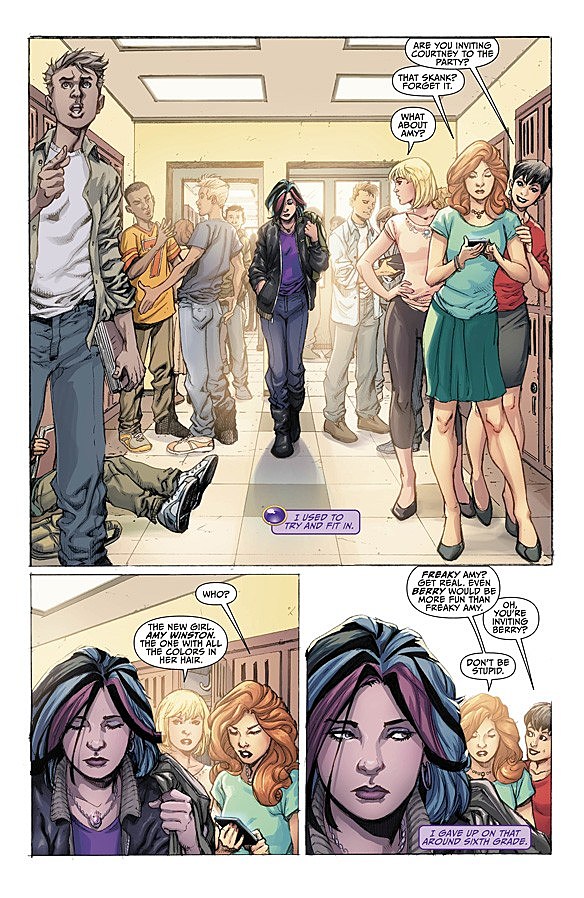![Writer Christy Marx On The Return Of ‘Amethyst’ [Interview]](http://townsquare.media/site/622/files/2012/09/amethyst00.jpg?w=980&q=75)
Writer Christy Marx On The Return Of ‘Amethyst’ [Interview]

Thanks to her work on TV shows like G.I. Joe and the creation of Jem and the Holograms, writer Christy Marx is already a ComicsAlliance favorite. This week, though, she's part of the team returning Amethyst, Princess of Gemworld to comics in the pages of Sword of Sorcery #0, and to say that we're looking forward to it is an understatement.
To find out more, I asked Marx about where she's planning to take Amethyst in her relaunch, whether she sees a problem in how superhero comics attract female readers, and just why the Misfits' songs were so much better than Jem's.ComicsAlliance: As a huge fan of Jem, I have to ask a few questions about that. Was there anything you did in your experience with that show that you're drawing on for Amethyst?
Christy Marx: Not directly, but I would say that doing the Jem series helped me to stretch myself as a writer. Prior to Jem, I was writing hard-action shows such as Spider-Man and G.I. Joe. While I did focus on character stories within those series, Jem pushed me farther in the direction of more character-driven stories. I learned that I could blend relationships, humor, and action effectively. It was an excellent learning experience that I feel has informed all of my work since then.
CA: Were you a fan of the original Amethyst comics, or was this a new project for you?
CM: Yes, I was. I collected the entire first run of the series, so I was familiar with what had been done when I was given the opportunity to bring it back.
CA: Is it going to be a hard reboot?
CM: My elf-like answer to that is both yes and no. No, in that it maintains the essence of the series: a young woman from Earth discovers she's the princess of a magic-filled realm. Yes, in that I'm working with an entirely new supporting cast of characters and am engaging in some new worldbuilding.
CA: It often feels like superhero comics have a difficult time attracting women and young girls as readers, while the animated shows based on comics tend to do a much better job of cultivating that fan-base. As someone who created a show for girls that still has a huge following, who's now taking on a comic series that originally found success doing the same thing, do you think that disconnect is there? And if it is, how do you deal with it?
CM: Being on television, animated shows are simply more accessible and it's easier to pick up a wider audience. Buying a comic requires a girl or woman to locate, travel to, and enter what can feel like strange territory -- a comics store. Savvy store owners will work hard to make their stores look and feel female-friendly, but it still takes an effort to get the female readers in the first place. There's been some growth of female readership over the past couple of decades and I think it can continue to grow now that comics are permeating more of the overall pop culture and being geek is finally chic. Having comics available in digital form could potentially help, too, as tablets become more and more a part of everyday usage.
However, as long as superhero comics, in particular, indulge in hypersexualizing female characters, there will be a barrier to reaching female readers. The solution is to stop doing it. Stop pandering to that mentality. I personally deal with it by writing what I enjoy reading or watching because that has proven to be a winning formula in reaching the readers or viewers I want to reach.
CA: How did you approach the project? You've worked on comics before, including a series you created, but is there a difference in how you approached working for DC on reviving Amethyst as opposed to TV or video games?
CM: Each form of media has its own requirements, freedoms and restrictions. Creating story for a videogame, a non-linear format, is entirely different from creating for a linear storytelling format such as TV or comics. TV series and comics have one thing in common -- they're forms of visual storytelling, they're episodic, and successful ones are ongoing for long spans of time. That means coming up with a mix of characters and situations that provide a lot of material to work with and have an "evergreen" potential.
I began by rereading the original series, making notes, tossing ideas around in my head, listening to my creative instincts, and playing with a lot of ideas until a series concept took shape and I had arrived at characters who felt complex enough and strong enough to carry the series.
CA: Did you go into it thinking of it as a long-term project, or as a short story?
CM: Definitely long-term. I have one large story arc that could span 1-2 years and a second large story arc lined up behind that, if I'm lucky enough to continue it.
CA: Are there other comics characters you'd like to work on? I'm a big fan of the Spider-Man and His Amazing Friends episode you wrote.
CM: At this stage of my career, what I would most like to do is work on my own original characters, but anything that allows me to do strong women characters or an interesting mix of characters would certainly appeal to me.
CA: Finally, did you intend for the Misfits' songs to actually be better than the Holograms'?
CM: [Laughs] Says who? Oh, wait, that's a Misfits attitude. I confess to a preference for the Holograms' music, but I think the composer and lyricists for the Jem series did a fantastic job on all the songs.






More From ComicsAlliance
![Cast Party: Who Should Star In An ‘Amethyst’ Movie? [Fantasy Week]](http://townsquare.media/site/622/files/2016/10/ame_featured.jpg?w=980&q=75)



![She’s A Problem Solver: Animator Brianne Drouhard Talks DC Nation’s ‘Amethyst: Princess of Gemworld’ [Interview]](http://townsquare.media/site/622/files/2014/07/Untitled-16.jpg?w=980&q=75)

![‘Amethyst: Princess of Gemworld’ Faces The Final Boss This Saturday On DC Nation [Video]](http://townsquare.media/site/622/files/2013/02/amethystlevel6main.jpg?w=980&q=75)

![Amethyst Faces Off Against A Surprisingly Apologetic Skeleton In Newest DC Nation Short [Video]](http://townsquare.media/site/622/files/2013/02/amethyst4main.jpg?w=980&q=75)
